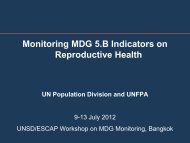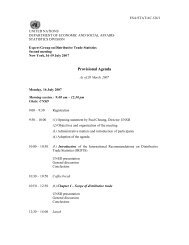demographic yearbook annuaire demographique 1951
demographic yearbook annuaire demographique 1951
demographic yearbook annuaire demographique 1951
Create successful ePaper yourself
Turn your PDF publications into a flip-book with our unique Google optimized e-Paper software.
are therefore misleading as to the actual rate of family<br />
formation.<br />
The completeness of the statistics within the framework<br />
of each country's legal definition of marriage varies considerably,<br />
depending on laws and practices with respect to<br />
the registration of marriages and the compilation of the<br />
results. Thus, some countries compile statistics only for civil<br />
marriages, although religious marriages may also be legally<br />
recognized; in other countries, the only records available<br />
are church registers and the statistics therefore relate to<br />
religious marriages only.<br />
Wherever possible the data presented in the tables relate<br />
to both civil and religious marriages (if both types of marriage<br />
are ret.:ognized) and are the number of marriages<br />
performed during the specified year, rather than the number<br />
registered or the numbers of marriage licences issued. The<br />
latter types of data represent fair approximations to the<br />
number of marriages performed. However, lengthy or variable<br />
lags in registration may distort the results somewhat.<br />
The number of licences issued always overstates the number<br />
of marriages performed since such licences are declarations<br />
of intent and are not in all cases followed by marriage.<br />
Known variations in definition or in coverage are noted in<br />
the tables. By virtue of the legal concept to which the data<br />
are bound, tribal or indigenous groups isolated from the<br />
dominant culture are invariably excluded from the statistics.<br />
Such exclusions are therefore not noted in the tables.<br />
Table 24 presents for 121 areas the number of marriages<br />
reported. for the years 1935 to 1950 and table 25 gives crude<br />
rates for the years 1930 to 1950 for 112 areas. The rate is<br />
the number of marriages per 1,000 persons in the corresponding<br />
midyear population. The very low rates shown for<br />
some countries, particularly in Latin America, are largely<br />
attributable to the prevalence ofconsensual marriage, though<br />
underregistration of legal marriages is in some cases a contributing<br />
factor.<br />
Crude marriage rates are of only limited value for analytical<br />
purposes. Marriages are more appropriately related to<br />
the "marriageable" population, i.e., widowed and divorced<br />
persons and single persons who have reached the age of consent.<br />
However, crude rates do measure changes and differences<br />
in the frequency of marriage in a total population,<br />
and fluctuations in the rate are often found to reflect changes<br />
in economic and social conditions.<br />
Table 26 presents statistics of divorces for 76 areas for the<br />
period 1935 to 1950. The data are affected by the same kinds<br />
of legalistic considerations as those described above in relation<br />
to the marriage data. They are perhaps affected by even<br />
wider variations among countries in the laws and regulations<br />
relating to the dissolution of marriage. These laws range<br />
from total prohibition (such countries, of course, report no<br />
divorces) to the ready granting of divorce in response to a<br />
simple statement of desire or intention. Naturally, numbers<br />
are relatively lower in areas where divorces are difficult to<br />
obtain, though variations in social mores are also a contributing<br />
factor to variations in the frequency of divorce. These<br />
two factors are not unrelated.<br />
A divorce is generally defined as a dissolution of marriage<br />
which is granted by legal process and which leaves the<br />
recipients free to marry again. Data known to deviate from<br />
this definition are so noted in the table.<br />
A number ofcountries include annulments in their figures.<br />
The number of these is usually quite small. An annulment<br />
differs from a divorce in that the preceding marriage is<br />
cancelled.<br />
In a few cases the data include legal separations. Normally,<br />
a legal separation is the granting of permission to the partners<br />
of a marriage to live apart, terminating their mutual<br />
marriage obligations (except that in some cases one spouse<br />
is required to assume certain financial obligations) but prohibiting<br />
marriage with another partner. In some areas,<br />
Sweden for example, legal separation is typically a preparatory<br />
phase to divorce, divorce being granted automatically<br />
after a stated period of legal separation.<br />
For countries where polygamic marriage is an accepted<br />
institution, divorce statistics have a somewhat different<br />
meaning. In these areas, the factor of freedom to marry a<br />
different spouse is relatively unimportant, at least for males,<br />
and divorce is more frequent than in other areas. Egypt,<br />
for example, recognizes three types of divorce (revocable<br />
divorces, suspended marriages and final divorces) all of<br />
which are concerned with the conditions under which the<br />
marriage in question may be resumed rather than whether<br />
other marriages may be contracted. They are also concerned<br />
with economic and financial obligations, but this is an<br />
element of divorce regulations in other countries as well.<br />
Only absolute numbers are presented in this volume,<br />
mainly because of the problem of an appropriate base for<br />
rates. The number of divorces is most properly related to<br />
the number of married persons or the number of married<br />
pairs, but statistics of the population classified by marital<br />
status are not available for most of the countries and years<br />
covered by the divorce data. A crude rate based on the<br />
total population, on the other hand, can be somewhat misleading<br />
as to the relative frequency of divorce among persons<br />
who are married and are, therefore, in a position to obtain<br />
divorces.<br />
Another consideration that renders crude rates of limited<br />
significance for comparative purposes is the factor of variation<br />
in the regulations regarding divorce that have already<br />
been mentioned. In any case, such rates cannot be taken as<br />
indicative of the actual rate of marital dissolution from the<br />
social and <strong>demographic</strong> point of view, for many marriages<br />
are broken in other ways than through divorce (as through<br />
death, desertion etc.). Divorce rates are likely to measure<br />
how well the population can afford divorce rather than how<br />
often family or marital dissolution actually occurs.<br />
LIFE TABLES<br />
Tables 27, 28 and 29 present life table functions for all<br />
those countries for which they could be obtained from<br />
official sources for any period since 1900. Figures are shown<br />
for one-year age intervals at selected ages up to age 85<br />
(for each year of age under 5 and for each fifth year of age<br />
thereafter). Three functions are given: (a) the probability<br />
of dying within one year or within a specified age interval<br />
for persons of exact ages specified; (b) the survivors at<br />
the beginning of each age interval out of a generation of<br />
100,000; and (c) the ~ean after-life or the mean expectation<br />
of life for persons at exact ages specified.<br />
Data are shown for 53 areas in the first two tables and<br />
for 52 areas in the third. As compared with the first issue<br />
of the Yearbook, the coverage has been considerably increased,<br />
but for many areas of the world no tables are<br />
presented because of the lack of reliable basic information<br />
on population and deaths.<br />
Life tables are based on observed mortality conditions<br />
for a selected period, but permit a more detailed analysis<br />
of the implications and prospects inherent in those condi-<br />
36













